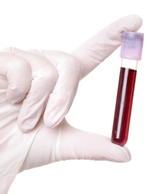Early Signs of Pancreatic Cancer Found in Blood
In a recent study, researchers found that certain amino acids in the blood were associated with a twofold increased risk of a pancreatic cancer diagnosis.
Could a blood test help detect early pancreatic cancer?

An increase in certain metabolites in the blood could be a future noninvasive marker for pancreatic cancer. Researchers at Dana-Farber Cancer Institute and other institutions found that certain amino acids-the building blocks of proteins-in the blood were associated with a twofold increased risk of a pancreatic cancer diagnosis. According to the study authors, the observation suggests that an increase in the breakdown of proteins in the body may be an early sign of pancreatic adenocarcinoma.
The results of the study were published in Nature Medicine.
A pancreatic cancer diagnosis often comes when the disease is advanced. This is because there are few distinct early warning signs of pancreatic adenocarcinoma. There are currently no screening tests to detect pancreatic cancer early.
Brian M. Wolpin, MD, a medical oncologist and researcher at the Center for Gastrointestinal Oncology at Dana-Farber Cancer Institute in Boston, and colleagues investigated whether there are differences between the circulating metabolites in prediagnostic blood plasma from pancreatic cancer patients and matched healthy controls. They found an increase in plasma levels of branched-chain amino acids in the pancreatic cancer patients. The increased risk associated with higher levels of amino acids was independent of other predisposing factors and was the strongest with plasma samples collected 2 to 5 years before the cancer diagnosis. The median time between blood collection from subjects and a pancreatic cancer diagnosis was 8.7 years.
The researchers also detected higher levels of branched-chain amino acids in a mouse model of early-stage pancreatic cancer and found that the elevated levels are dependent on mutant Kras expression.
Increased levels of branched-chain amino acids have been previously associated with those who are obese or those who have insulin resistance. Pancreatic cancer has also been linked to changes in metabolism, such as obesity and glucose intolerance.
Still, more research is necessary to understand how and whether this change in amino acids could potentially be applied for pancreatic cancer screening. For now, the researchers point out that the differences in levels of the metabolites are not great enough to warrant the development of an early detection test. “As a standalone test, branched-chain amino acids do not have the sensitivity or specificity necessary to be used as a population screening test for pancreatic cancer,” Wolpin told Cancer Network. Instead, Wolpin sees this marker being used in conjunction with other risk factors, such as smoking, inherited genetic variants, and other potential circulating markers, to create a risk stratification tool.
Pancreatic cancer, and particularly advanced disease, is strongly linked to cancer cachexia. Pancreatic tumors have been shown to use amino acids to support their growth, but whether the same is true of branched-chain amino acids is not yet clear. Wolpin and colleagues will next investigate whether breakdown of muscle provides a source of branched-chain or other amino acids for pancreatic tumors, as well as the timing of this process during pancreatic cancer development. “We are now working to better understand how amino acids are mobilized from muscle by early pancreatic cancers and whether the amino acids are being used by the tumor. These mechanisms are important to understand, if we are to leverage the published findings for risk stratification and new treatments,” said Wolpin.
Whether higher levels of these branched-chain amino acids may also be associated with other types of cancer is not yet clear, Wolpin told Cancer Network. The team analyzed mouse models of lung cancer and sarcomas but did not see the higher levels of the metabolites detected in mouse models of pancreatic cancer. “Further work needs to be done to determine whether this is truly specific to pancreatic cancer or a more broad-based biology,” said Wolpin.